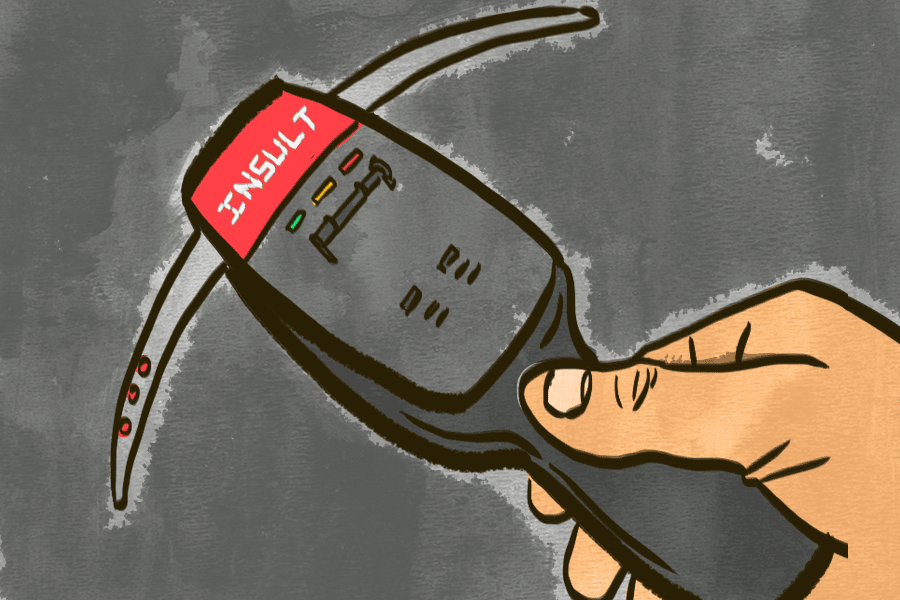One of the weirder features of being a guy is our preferred method of letting other guys know we value them, trust them and enjoy hanging out with them: By being spectacularly, unforgivably rude toward them in public.
An unfortunate side effect of this bizarre ball-busting bonding ritual, however, is that it’s occasionally difficult to tell whether jibes made in our direction by guys we’re not too familiar with are meant with genuine affection, or genuine seething malice.
This is especially true if you happen to be what body language-expert Joe Navarro calls a “social aardvark.” “They’re people who just don’t get it. They’re either serious, or they’re challenged when it comes to any kind of social interaction,” explains Navarro, who worked for 25 years as a bona-fide spy-catcher for the FBI and wrote the body-language bestseller What Every Body Is Saying.
So if you can’t tell whether that intimidating co-worker, potential in-law or pugnacious new recruit to your organized crime syndicate wants you to play along with their ribbing or curl up and die, here are some tips for aardvarks everywhere…

Context Is Everything
The first rule of figuring out the intent of someone’s words, says Navarro, is that while you shouldn’t ignore the content of what your challenger is saying, you should always put their words in the context of the “non-verbal” side of the conversation — that is, their body language, tone of voice and other factors specific to the situation.
“Communication is a mix of verbal and nonverbal together,” he explains. “We know that because when you take a person and you restrain their arms, it affects their ability to use words, and even their recall.”
In fact, according to two seminal studies conducted in 1967 by Albert Mehrabian, a psychology professor (now emeritus) at UCLA, in face-to-face conversations where the nonverbal signals appeared to contradict the spoken message, those unspoken cues turned out to be a far more reliable guide to the subject’s motives. When signals are mixed, Mehrabian found, only 7 percent of the intended meaning is conveyed by the words, while 38 percent is carried by the tone of voice, and the remaining 55 percent is in the body language.
It’s important, then, to take in the whole scene when assessing a person’s motivations. Sensibly enough, you start with first impressions, says Navarro. If at the moment of greeting or introduction, you find your adversary “welcoming, jovial, or, let’s say, brotherly or sisterly, that sets the foundation; this tells me ‘I’m welcome here.’”
Easy enough. Next, you take into account what he calls “venue expectation”: “Where are you? Are you at a playground? Are you at a bar? Are you at the beach? There are places where you have greater latitude in how you interact with others, and how you behave,” explains Navarro.
Basically, if the banter is out of step with the mood of your surroundings, that’s a big clue something’s off. The drastically limited scope for ball-busting in a business meeting is a good example: “When you’re in somebody else’s office, you’re not allowed to look around like you’re a radar — you’re actually, by social convention, only allowed to look at that person, or where they direct you to look.” So if they’re avoiding eye contact or checking their emails while saying something that sounds mildly insulting? That’s probably not respectful banter.
Look for the Big Body-Language Giveaways
When it comes to reading physical gestures, Navarro warns against applying hard-and-fast rules — if someone under interrogation scratches their nose, for example, it doesn’t necessarily mean they’re lying. He’s particularly wary about “micro expressions,” the supposed quick-as-a-flash facial contortions people make when they’re being dishonest, made popular in the last few years by psychology-infused crime TV shows such as Lie to Me. “Micro expressions are an over-hyped concept,” he says, and are “actually very rare.”
Instead, he recommends a holistic approach, focusing on the arms, chest and feet, as well as what the face is doing. In the case of affectionate ribbing, your haranguer is likely to display a general “lack of rigidness — they don’t look like a drill instructor; they look relaxed; their palms are up; they’re either smiling or they just look cheeky.”
The orientation of their body in relation to yours is also important. “There’s a difference between somebody standing in front of you with their chest puffed out saying something that’s ribbing,” says Navarro, “and somebody who’s off to the side, looking away, being gregarious. The first is confrontational; the other one is very benign.”
Lastly, always, always check their feet. In his authoritative 1994 guide to gestures, “Bodytalk,” the influential British socio-biologist Desmond Morris wrote, “Generally speaking, our feet are the most honest part of our bodies. This is because we’re less aware of them than parts nearer the face.” When, for instance, two people who don’t like each other run into each other at a party, says Navarro, “they’ll look at each other, but you’ll notice their feet are already turning away.”
This is because “when we don’t like people we tend to orient away from them — and we usually do it first with the feet.” We do so, he explains, partly as a survival measure, since turning the feet also begins to turn our ventral side (the vulnerable “belly” side of our torso) away from a potential enemy.
Meet Banter With Banter
When entering an unfamiliar new social environment, Navarro advises that the most advantageous approach is usually to mirror the dominant behavior of the group. Luckily, mimicking others’ behavior tends to be our default social state, at least for normal, non-aardvark adult interactions. In fact, it’s a habit that appears to be hard-coded into our heads, thanks to the presence of “mirror neurons,” enigmatic circuits in our brains that some neuroscientists believe perform a key role in our ability to empathize and form social connections.
Mirroring behavior, as Navarro points out, is such a basic, natural part of male bonding we rarely notice we’re doing it. “If they’re talking about sports, you don’t come in and talk about politics,” he observes. “Or you’ve got three guys standing over their beer at the bar? Well, you join them and you do the same thing. We assess first, and then we mirror whatever the emotion or the activity is. That contributes to harmony.”
That’s why the best way to handle having your balls busted — and thereby slickly gain acceptance in your immediate social vicinity — is almost always to step up and bust them right back.
Navarro neatly illustrates this with an encounter he recalls from his childhood. “If they said, ‘Oh man, where did you get those shoes? Are they giving them away at the garbage dump?,’ I would go, ‘No, no, no, not the garbage dump. I got them out of the same trash can where you got your shorts.’ And then it’s magical. You’re friends forever.”

